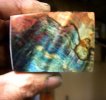I’ve come to the opinion that we need a new word for the “stabilization” that places like K&G provide versus all of the home brews, including cactus juice. I’m tired of cutting into “stabilized wood” only to find that it never fully penetrated. At this point I only buy wood that I know has been commercially stabilized by a few places. I use stabilized wood for the specific properties true stabilization provides and I don’t want to sell knives with handles that won’t live up to the expectations. YMMV
Yes maybe a new definition. For me, I am happy enough with 'cactus juice,' and home brew as you call it. I do not mind that it still has the properties of wood. I am not as connected to material that has been turned into plastic. In my view anything at all that gets done in the way of impregnating with any resin, is added strength to the existing wood. It's a step up from simply doing a overcoat on the finished handle of plain wood. I think there are different levels, price ranges, qualities, in any stabilizing project, same as heat treat of steel. Same as stabilizing fossils for museums, knife work, or display. We can pay different amounts, and ask for different finished properties. As with heat treat and name a Rockwell hardness but was it double tempered, cryo treated and what tests did it pass? What is it made for, who is the market, what is it sold as ,or meant to do? a display knife? I'm told some top knife makers do not even bother to heat treat the steel, it may as well be a butter knife, no one is expected to cut anything with it. Are we told this?( I have only heard from collectors, no names or first hand knowledge) ) For $1,000 or whatever on up, I'd expect a knife that can cut something! But that's me. I assume then there are a variety of markets and people who meet that market. If my stabilized wood is not perfect inside like it didn't penetrate all the way, so what? That side goes against the steel. I may seal it and if I pin it correct, it's not going to warp off the steel. or swell shrink more then plain wood. At worse, I cactus juice it one more time after I cut it. It's not the end of the world. If the outside is hard, stable, looks good - functionally it is as good a finished product as any other stabilized wood. Unless I am wrong. I carry and use knives a lot and put them through brutal tests. In the rain, beating on them, cutting wire, heads off nails, submerged in gas and solvents, skinning in 60 below cold. So feel if it holds up 'for years,' That's good enough for my standards. I'm sure there are different views. I mean no disrespect. Back to maybe yes, different definitions. But 'honesty' might be to say "Stabilized by" or such and such a method (by me) "Using cactus juice." You make it sound like "May as well toss that knife in the trash!"Most of my customers give a blank stare if I get into to much detail. They understand, "If for any reason you are unhappy, get back to me and I'll make it right." If my handle fails I'll refund your money, lifetime guarantee. Two in my life got returned. One chef put his knife in the dishwasher and I had to tune up the handle. The other was a jade handle the guy requested, who beat on it with a hatchet. I Honored my guarantee. I sent off some wood to K&G and was happy enough I guess. Paid some amount - way more then doing it myself. Waited a few weeks. Could only afford a dozen blocks. So an advantage in home brew is, lots of finished wood to match to my design- so better match and look. More choices for my customers. A dye job to suit the exact look I am in control of (for example I soak in up to 3 dyes) and thus artistically a better product, in terms of what I am trying to say with the look of the knife. I can afford to toss out wood I think is not impressive after being done. I do not have to wait. The same could be said about home heat treat. Can the customer trust it? Does it need another name? In my view, how the blade is heat treated is half the knife. If I send a blade off for heat treat, the guy who heat treated did half the job, as half the maker of the blade. Beyond type of steel, heat treat is the biggest factor in separating a good knife from a poor one. Beyond just looks. The more we do ourselves, the more we can honestly call it our custom knife. In my view, the more it has our personal look and identity. So what are we striving for? I'd say I am not perfect, neither are my knives. My life depends on my knife in the wilderness, they work for me, I'm satisfied. I don't rely on someone else's good name connected to my work. Is quality compromised? Yea long reply. I'm bored, on a break, rain out. Headed back to the shop to do some more home brew work. (grin)

